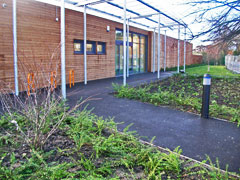ICAX™ – Merton's Acacia Centre – The Merton Rule
Merton Council reports on its new Acacia Intergenerational Centre:
After a tough selection process, Merton has been given £1.5 million by the London Development Agency (LDA) which will, along with other funding, build the UK’s first purpose-built Intergenerational Centre. Work begun in 2009 to clear the site – a disused youth centre and motorbike track situated next to Lonesome Primary School and St Mark’s Academy in Eastfields, Mitcham. The Centre, which opened early in 2010, is designed to bring together different generations, young and old, as individuals, groups and families. The Centre aims to help break down stereotypes and barriers, and complement the new Children’s Centre and daycare provision all operating under one roof.

Merton's Acacia Intergenerational Centre
Curl la Tourelle
Dean la Tourelle of Curl la Tourelle Architects reports that:
Initial consultation and design work is proceeding well on an exciting new project for the UK's first Intergenerational Centre in Merton, London. The centre will offer facilities and training for young and old. Its range of programmes is aimed at breaking down barriers between different groups in the community. The explicit intention is to work across generations to increase mutual understanding and social cohesion, and to develop a greater sense of community spirit and reduce crime. The anticipated completion date is early 2010.
Curl la Tourelle are architects who specialize in architecture for education, housing, community and leisure. They "enjoy defining and solving problems".
While Curl la Tourelle are always "concerned about the impact that buildings have on the world's resources and work to ensure that sustainability issues inform functional, aesthetic and construction decisions", there was a particular need to demonstrate this in working for the Merton Council. Merton has made a point of leading the field in requiring new buildings in its borough to incorporate on site renewable energy for at least 10% of predicted energy requirements: The Merton Rule. The original Merton Rule has been much copied by other boroughs, strengthened by requirement of more than 20% of On Site Renewable Energy and the spirit of it is now incorporated in the UK government's target of Zero Carbon Schools by 2016.
Biomass Boiler
Initially the architects looked at the standard biomass boiler "tick-the-box" response to providing on site renewable energy. The costs of this "inelegant" solution grew as they allowed for storage facilities for the woodchip fuel, provision of space for delivering fuel to the site and the practicalities of managing a biomass boiler installation. A review of the energy requirements for the well-insulated building pointed to the need for cooling in summer – which the biomass boiler would not have been able to provide.
Search for an alternative to a Biomass Boiler
The architects searched for alternative means of meeting the Merton Rule in conjunction with their M&E advisors, Halcrow Yolles, and contacted ICAX Ltd. ICAX were able to offer Interseasonal Heat Transfer which would meet the heating loads of the building in winter largely from heat energy extracted from the building in summer – by means of storing surplus summer heat in ThermalBanks™ until it was needed for heating in winter.

Cost constraints
An examination of the costs involved showed that the ICAX proposal was less expensive than the provision of a separate biomass heating system and an electrically powered air cooling system. It also took up less space and saved the cost of constructing a special building to house the fuel supply for the biomass boiler.
Further analysis showed that the annual running cost of the IHT system would be less than the cost of running biomass heating in winter, electrical cooling in summer and gas heating for hot water in summer.
A final analysis was required to calculate the Carbon Offsets in comparison to the carbon emitted by the standard solution of using a gas boiler for heating. Both the ICAX proposal and the system incorporating a biomass boiler showed that it was possible to provide over 40% of on-site renewable energy to Merton's Intergenerational Centre.
The elegant solution
The architects decided to go for the "elegant" solution in which one integrated system from ICAX could provide both heating in summer and cooling in winter (as well as hot water all year round and the freedom not to have to organise, feed and manage a biomass boiler).
A demanding building
The sustainability statement from Halcrow Yolles, the M&E Consultant, discusses the heating and cooling needs of this prefabricated building and concludes that ICAX's ground source heat pump with intelligently controlled thermal bank is an elegant and low carbon solution to an otherwise demanding building. See the Halcrow Yolles Sustainability Statement on the Merton Intergenerational Centre.
Intrabuilding Heat Transfer™
The Merton Acacia IGC is the first building in the world to benefit from Intrabuilding Heat Transfer™ as well as Interseasonal Heat Transfer™.
Groundbreaking environmental features
The building features a number of groundbreaking environmental features including the world first's use of technology which heats the building using natural energy captured from the building itself in summer (as a by product of cooling) and stored in boreholes buried deep in the ground. The new system uses an advanced ground source heat pump, linked to the boreholes, which recycles the stored waste heat back to the building in winter: Ground Source Heating and Cooling
A "Very Good" BREEAM score was awarded for the Acacia IGC.
British Construction Industry Awards
The Acacia Centre, Merton, was shortlisted for the British Construction Industry Awards in 2011.
See also Greenfield Supermarket Store which uses the same principles to save energy, carbon and money.
See Ground Source Heating See Ground Source Cooling See Ground Source Energy



